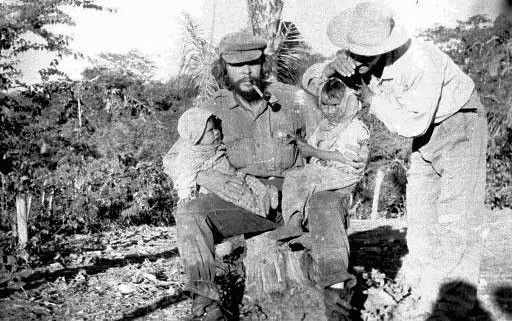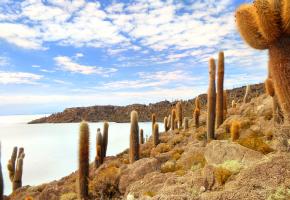Ever since I read Che Guevara’s Bolivian Diaries in 1970, I had always wondered about that remote region where he fought, died, was buried, and his corpse was finally unearthed. ‘Here’s my chance!’ I thought when I was recently asked to translate a book by Argentine painter Ciro Bustos dealing with some of the events surrounding Che’s guerrilla movement in Bolivia. Little self-persuasion was needed to decide on the journey to the terrain in order to describe it better in the book.
First stop, though, was La Paz, the capital of Bolivia high in the Andes at 3,500 metres, far from the low agricultural region where Che fought. When I recovered from two days laid low by the ‘mal de soroche’ (altitude sickness), I met Loyola Guzman who acted as liaison between Che’s guerrilla’s and the Bolivian Communist Party, then Antonio Peredo a well known journalist whose two brothers ‘Inti’ and ‘Coco’ fought with Che, and finally Carlos Soria another journalist who has spent a life-time studying the whys and wherefores of Che’s defeat and is one of the few people to have actually seen Che’s original diary kept in Bolivia’s central bank. In a field where so many people have so many different versions of events, his website gives as fair a rundown as possible. www.chebolivia.com
Into Che's Bolivia
My head spinning with so much talk of Che, I took the plane toSanta Cruz, capital of the large eastern province of Bolivia, which unlike the freezing Andean part, is warm, humid and even semi-tropical in areas, and where the desire for autonomy is a big issue. From there I had a five hour bus journey into the mountains to Vallegrande, now a sleepy agricultural town in a beautiful green valley. In 1967, however, it was bristling with soldiers of the Bolivian army’s anti-guerrilla campaign.
By starting in Vallegrande, I would in fact be following Che’s footsteps backwards. After Che was shot, his body was thrown in an unmarked common grave together with eight other guerrillas killed in the last combat of the guerrilla war. For thirty years, its whereabouts was a Bolivian state secret until permission was finally given for, first Argentine, and then Cuban forensic scientists, to search an area near the town’s airport where it was thought to be. The bodies were eventually unearthed in 1997. Che’s remains were taken to Cuba where they lie in state in a mausoleum in Santa Clara, scene of Che’s great victory, but Vallegrande boasts a tasteful commemorative building to mark the site, part tomb, part photographic exhibition paid for by the Cubans. Close by is another garden with the graves of eight more guerrillas - Cubans, Bolivians, Peruvians, and Tania, the German-Argentine who was the only female guerrilla.
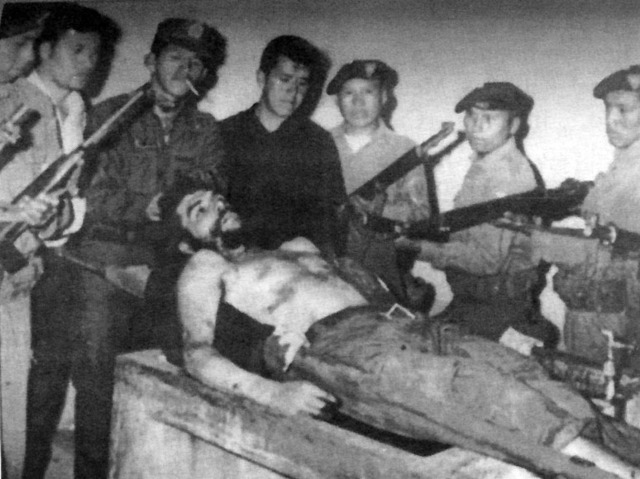
Moving back in time, the other main memorial to Che is the wash house in Vallegrande’s hospital where his body was taken to be prepared for exhibition to officials and the press. The iconic Christ-like photo of Che, slightly smiling and eyes open, laid out on the stone slab is world famous. In 1967, it was the townspeople filing past, now it is disciples of Che from all over the world who make the pilgrimage to the tranquil spot and leave messages. I hate graffiti normally but I found the words left on the walls of this small hardly changed adobe building, very moving. Just a handful of youngsters was visiting the small white adobe building, and the sun was shining on the bright green grass, surrounded by beautiful rolling hills, but it was an amazingly harmonious experience. If I’d had a pen I’d have been moved to write a message to Che myself.
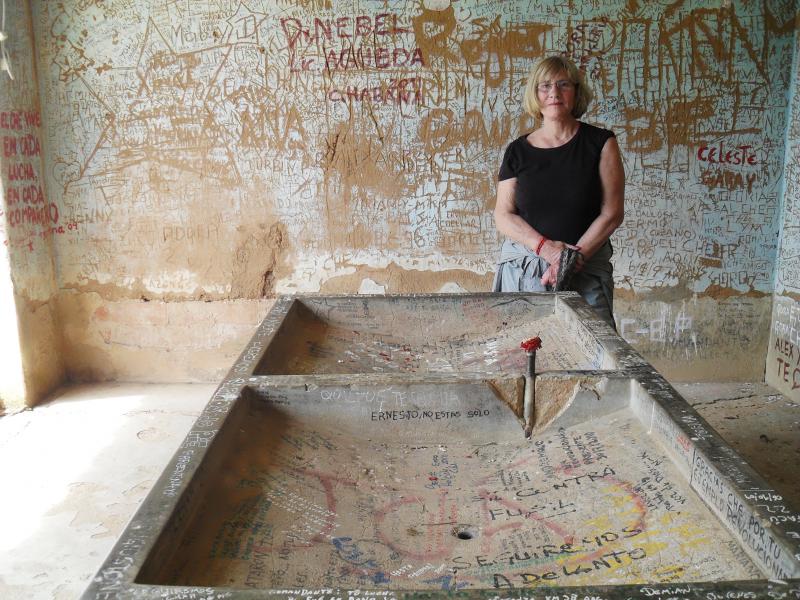
Finding the Spirit of Che in La Higuera
Another three hours away in a pick-up truck, through the spectacular scenery of sometimes wooded, sometimes cleared, mountainsides, sparsely dotted with hamlets (including the eastern-most Inca village of Pucará), is the village of La Higuera where Che was shot. The story has been told and retold many times over the four decades since the event as the pieces of the picture have been put together. To say the village has hardly changed would not be true. It has been embellished or disfigured (according to your point of view) by a small plaza with a huge statue of Che, another bust with a cross on a large stone (reflecting the increasingly synchretic politico-religious nature of the Che myth), a new community centre cum clinic with Cuban doctors in situ, and most incongruous of all two backpacker hostels in exquisite taste run by French people (it is literally in the middle of nowhere but you can get an expresso coffee and a delicious salad with proper vinaigrette).
One of the hostels is the former house of the telegraphist who informed the army the guerrillas were there: odd an historic monument should have been allowed to be privatised. But at the same time, La Higuera is still a tiny Bolivian village with unpaved streets, adobe houses and country people going about their country business, much as it was when Che was held in the adobe schoolhouse (now a museum) in 1967. It is slightly surreal. The locals mingle with people from all over the world. Some are ageing hippies like myself, but most are young people who have come huge distances to sit all day, and sometimes all night, and just commune with Che. Many are his compatriots from neighbouring Argentina, born when to merely mention the name of Che would get you killed or disappeared, discussing his example of sacrifice, his selflessness, his humanity, his social conscience, his sense of justice, his international solidarity, his ideas of fair trade, etc. To them, these eternal yet modern beliefs, in a world of corruption, self-interest, and greed, are to be revered.
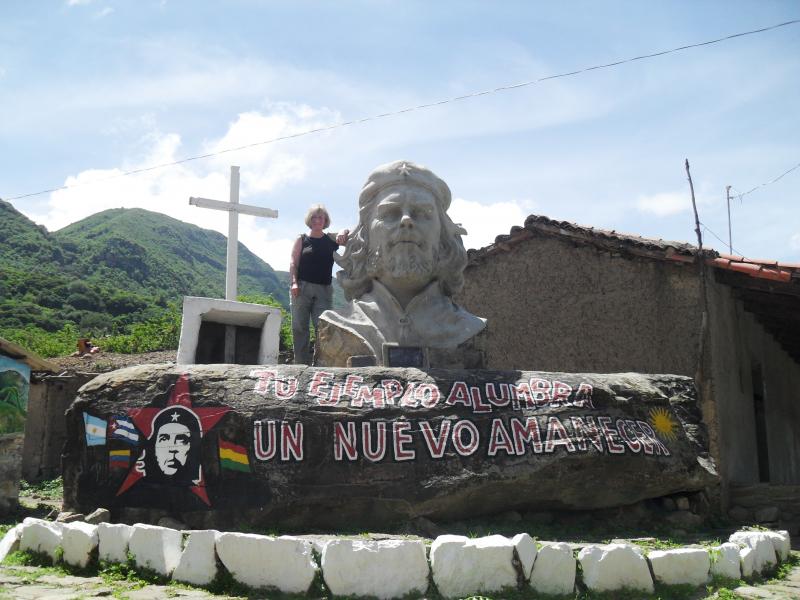
The Last Days of Che
The next step is the trek to the Quebrada del Churo where the final battle of the guerrilla war was waged. We walk down a very steep track for about an hour through thick undergrowth to a place by a river where Che with about 16 of his few remaining guerrillas were encircled by a couple of thousand US trained Bolivian rangers, according to our guide 72 year- old Policarpio (possibly an exaggeration). Che was wounded in the calf early on, and surrendered to save the rest of his men (eight were able to break through the cordon after the firing stopped.) He apparently said “No tiren. Soy el Che. Valgo mas vivo que muerto.” Until then it was not known for absolutely sure whether it was Che himself leading the guerrillas, since he went by the nom de guerre Ramón and never wore his beret with the star in Bolivia.
Again, it was surreal to lie there in the sun on the stone, under which Che had taken refuge when his rifle was shot out of his hands, and listen to Policarpio recounting how the local people betrayed the guerrillas because the army told them they would take their women, their animals, their land. All the statues and slogans cannot hide the fact that the guerrillas never got support from the local population as they did in the Cuban revolutionary war. That is said to be one of the reasons for the defeat. Added to which, although the majority of the guerrillas were Bolivians, they were perceived as Cuban and, as such, an invading force. Coming here did away with one misconception I had had. When I read that Che had found the Bolivians hermetic, fearful and unresponsive, I (and I think many Europeans) assumed he was dealing with the Quechua and Aymará people we associate in our minds with Bolivia. I really didn’t know that in these parts they are mestizo campesinos mixed with Guarani Indians: not the Andean Indians as I had imagined.
I left La Higuera thinking it would be an amazing place to spend more time. When you have taken the trouble to come this far driven by the Che factor, you find a sublimely beautiful place, with nearby hot springs, cave paintings, fantastic walks or rides, everything you need to have a great rest (even the expresso).
Che in Camiri - where the guerrilla started
Retracing my steps to Vallegrande, then to Santa Cruz, I took a five hour bus trip south to Camiri, back to the area where the guerrilla war had started.
The bus for Camiri had a couple of mishaps on the way and didn’t arrive until 1.30 am. It is an indication of how safe Bolivia is compared to other Latin American countries that I got in a taxi with four unknown blokes and went through a few unlit seedy areas dropping them off until I got to the main square. I had picked the Hostal Londres out of the phone book but it turned out to be full, so I went to the Oriente around the corner. The next day, passing the Londres, I saw a plaque outside saying Tania had stayed there. I went in and found a painting of Che over Room 7 where he too had stayed on his way to Ñancahuazú in 1966. (And to think I might have inadvertently stayed in it!)
I drove a couple of hours to the small colonial town ofLagunillas. It is mentioned in Che’s diary as the place where Mario Chavez, known as El Lagunillero, had a hotel/restaurant and acted as a contact for the guerrillas. The Bolivians among them semi-socialized there initially, and the locals thought they had come to grow coca. The road to Lagunillas was breathtakingly beautiful with the densely forested Macizo del Incahuasi mountain range, where Che started operations, to our right. The land was dotted with small fincas mostly growing a few fields of maize, or rearing a few cattle, emphasizing why Che met with puzzlement when explaining to these subsistence landowners they were being exploited.
We continued on to Ñancahuazú, the finca the guerrillas bought as their base, known as la casa de Calamina because of its zinc roof. Behind it up in the mountains with a view over the finca, Che built his first campamento. Unfortunately, shortly before arriving we got caught in a torrential downpour and had to turn back as the sandy dirt road would soon became impassable and we’d be stuck. The rain went on all night and through the next day, it was the rainy season, so our planned trip to Monteagudo, another village mentioned in Che’s Diary, and Muyupampa where Debray and Ciro Bustos (whose book I'm translating) were arrested, also proved impossible. A couple of days waiting brought no let up in the rain. I had to carry on down into the north of Argentina to the Chaco Salteño where Jorge Masetti and Bustos set up Che’s Argentinian foco and founded the Ejercito Guerrilero del Pueblo. But that is another story.
So sad to recount, my Che Bolivia trip was aborted. I may never know what those last iconic places in the Che story, like the Vado del Yeso, look like. But I thoroughly recommend the Ruta del Che (warts and all) for all you Che disciples. And also for those of you who just want fantastic scenery, peace and quiet, and great trekking in totally unspoilt places.


